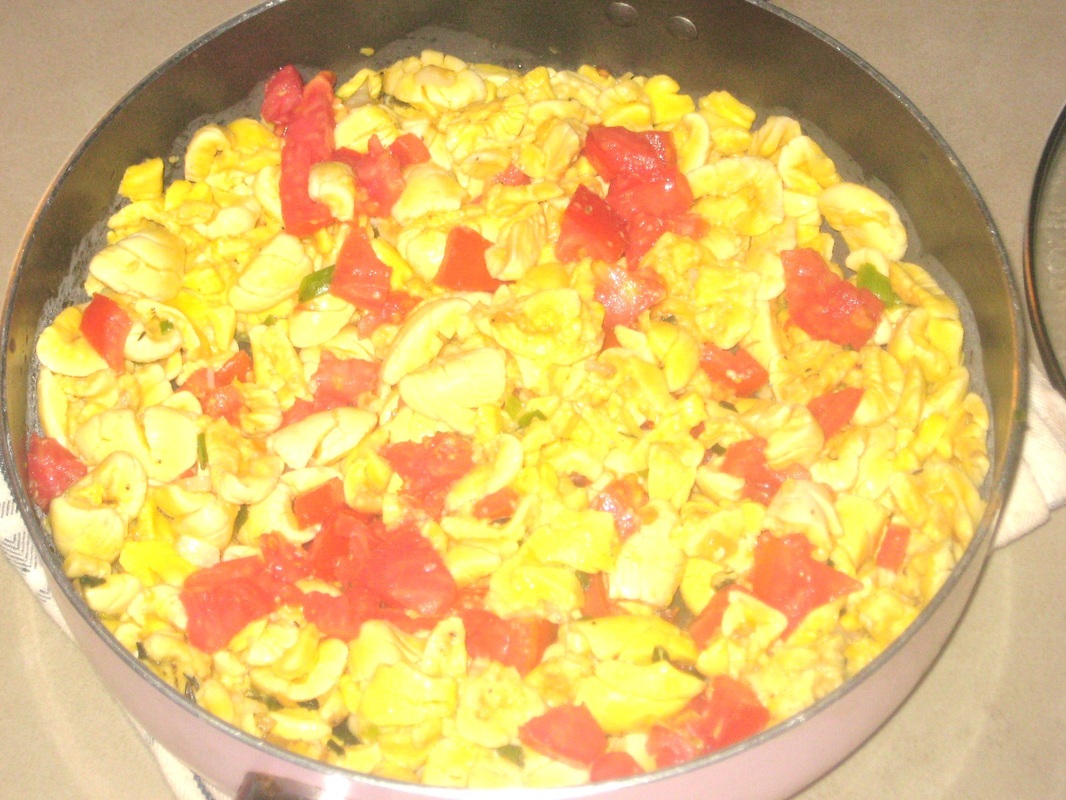A small fruit about the size of a toddler’s fist dangles 25 feet above the ground as Shane (a new Jamaican friend) and Ashton gently dislodge it. Reddening in the morning sun, this tropical fruit tree has pinnate evergreen leaves that spread out in 6 to 10 elliptical leaflets. The pear shaped pod is not any tropical fruit; ackee is the heart of Jamaican cuisine.
Although native to Africa, it has naturalized and become rich in Jamaica’s culture. Most likely imported here in the 1700s along with the slave trade, ackee was taken to England and named Blighia sapida by the discoverer Captain William Bligh.
The fleshy fruit is only edible when the pod’s bottom splits open revealing the dark black shiny seeds. The seed and orange insides are removed leaving the yellow arils. The arils are then boiled, changing the water twice. As a stir-fry with scallions, tomatoes, and calilou or as a main dish with salt fish, this island staple resembles scrambled eggs in appearance, tastes buttery, and has a firm melon texture.
Canned ackee is a major Caribbean export especially to the USA, although the fresh fruit is much better. Referred to as vegetable brains, ackee is a complex carbohydrate rich in linoleic acids essential to human health. In total, 22 diseases have been recognized to be healed with ackee. Dental decay, fever, malaria, internal hemorrhage, dysentery, burns, eyes inflammation, yellow fever, constipation, cutaneous infections, whitlow and head lice are the most common. All parts (bark, seeds, roots, leaves) are involved in the composition of drugs. The bark is useful in the treatment of 13 different diseases followed in decreasing order by leaves, roots and seeds. This type of knowledge is kept mostly by old people and traditional healers in the communities and varied sometimes from one ethnic group to the other.
That night we dined on an ackee stir-fry. First I boiled four cups of ackee twice in water and rinsed it in between boilings. I sauteed two tablespoons of butter with three tablespoons of scallions and a fresh chopped tomato. Next I added the drained ackee into the stir-fry.
What a wonderful way to celebrate Jamaica Day, our friends, and new foods!
Although native to Africa, it has naturalized and become rich in Jamaica’s culture. Most likely imported here in the 1700s along with the slave trade, ackee was taken to England and named Blighia sapida by the discoverer Captain William Bligh.
The fleshy fruit is only edible when the pod’s bottom splits open revealing the dark black shiny seeds. The seed and orange insides are removed leaving the yellow arils. The arils are then boiled, changing the water twice. As a stir-fry with scallions, tomatoes, and calilou or as a main dish with salt fish, this island staple resembles scrambled eggs in appearance, tastes buttery, and has a firm melon texture.
Canned ackee is a major Caribbean export especially to the USA, although the fresh fruit is much better. Referred to as vegetable brains, ackee is a complex carbohydrate rich in linoleic acids essential to human health. In total, 22 diseases have been recognized to be healed with ackee. Dental decay, fever, malaria, internal hemorrhage, dysentery, burns, eyes inflammation, yellow fever, constipation, cutaneous infections, whitlow and head lice are the most common. All parts (bark, seeds, roots, leaves) are involved in the composition of drugs. The bark is useful in the treatment of 13 different diseases followed in decreasing order by leaves, roots and seeds. This type of knowledge is kept mostly by old people and traditional healers in the communities and varied sometimes from one ethnic group to the other.
That night we dined on an ackee stir-fry. First I boiled four cups of ackee twice in water and rinsed it in between boilings. I sauteed two tablespoons of butter with three tablespoons of scallions and a fresh chopped tomato. Next I added the drained ackee into the stir-fry.
What a wonderful way to celebrate Jamaica Day, our friends, and new foods!



 RSS Feed
RSS Feed
